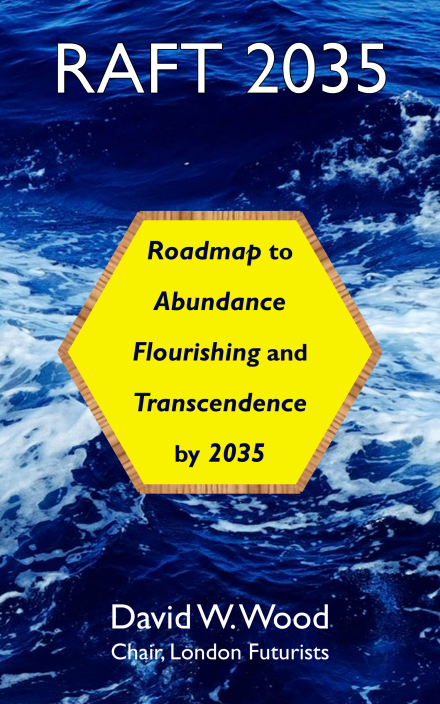This page contains the opening portion of Chapter 1 of RAFT 2035.
Copyright © 2020 David W. Wood. All rights reserved.
1. Physical wellbeing
Goal 1 of RAFT 2035 is that the average healthspan in the UK will be at least 90 years (up from 63 as at present).

The rationale for this goal is that good bodily health is the starting point for all other activities. Declining health diminishes human opportunities and curtails human freedoms, as bodies and minds become enfeebled. Declining health can also impose huge social and healthcare costs. Sadly, the healthcare budgets in countries all around the world are already creaking under severe stress.
However, there will be significant benefits, both socially and economically, to delaying the onset of chronic diseases of aging and thereby extending healthspan. These benefits are known as the “longevity dividend”. Happily, these benefits now lie within our grasp.
Boosting healthspan
Healthspan has been defined as the amount of time an individual can live independently, without being hospitalised or requiring regular support from healthcare assistants or family or friends. It can also be measured as the amount of time that someone would assess their own health as being “good” or “very good”.
The latest figures from the UK’s Office of National Statistics for expected lifespan in the UK are 82.9 years for women and 79.3 for men. The same data source states that “healthy life expectancy” is 63.6 years for females and 63.1 years for males. In other words, these figures predict that someone will, on average, be fully healthy for only 77 to 80% of their lifespan.
Unfortunately, the figures for expected healthspan are actually declining. For example, the expected healthspan for women has decreased by three months over a six year period (from 2009-11 to 2015-17).
But things don’t need to be this way. We can look forward to three overlapping waves of improvements in how people age:
- Technology that helps people to “age in place” better, so that, despite aging, people can lead fuller lives. This includes better monitoring systems to give early warnings of impending ill-health, better mobility solutions to reduce the need for people to rely on assistance, and better networking systems so that, despite diminished mobility, the elderly remain connected to their family and friends and have a rich social life.
- Technology that enables more people to live like the “superagers” who age more slowly than the average person. A superager might live like they’re 75, despite being 95 or older.
- Technology that enables people to be “forever young” (if they choose it): they could live like they’re 35, despite being 125 or older.
Learning from superagers
Superagers are defined as people who reach the age of 95 without being impacted by cardiovascular disease, cancer, diabetes, cognitive decline. It’s notable that superagers are often siblings or cousins of each other.
As well as aging more slowly, superagers tend to require less healthcare, even in the twilight years of their lives. They typically experience what is known as “compressed morbidity”. A superager can utilise less medical budget throughout their long lives, in total, than a shorter lived neighbour who spends many more years in declining health.
A number of researchers are avidly studying superagers, to understand how they differ from the rest of the population, in terms of lifestyle, but also in terms of genetics and other biological features. The goal of this research is to understand what treatments and medical interventions might be made available to the rest of the population, so that superaging becomes the norm, rather than (as present) the exception.
As well as learning from human superagers, it is possible to learn from a number of animal species that manifest various kinds of superaging, and even, in some cases, negligible senescence.
<snip>

